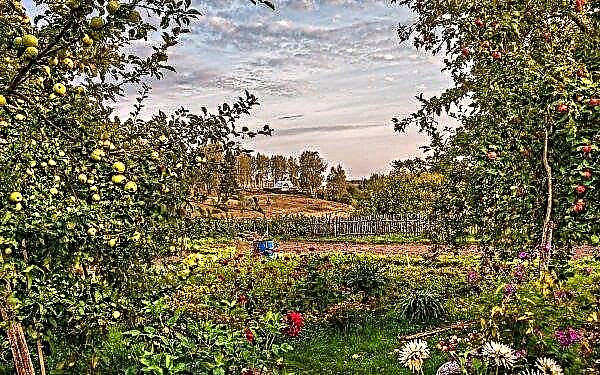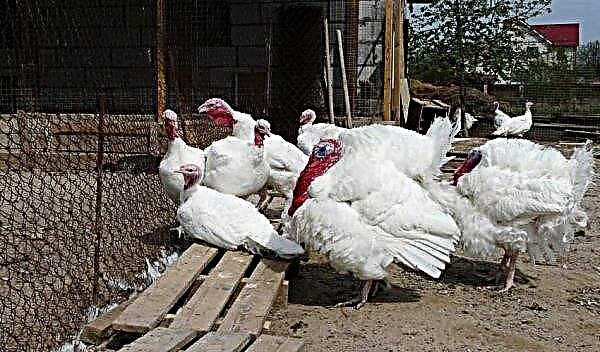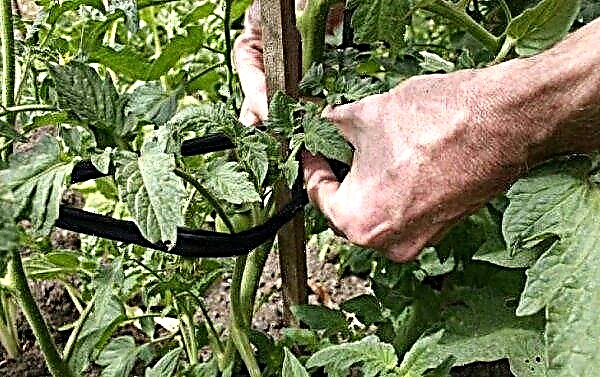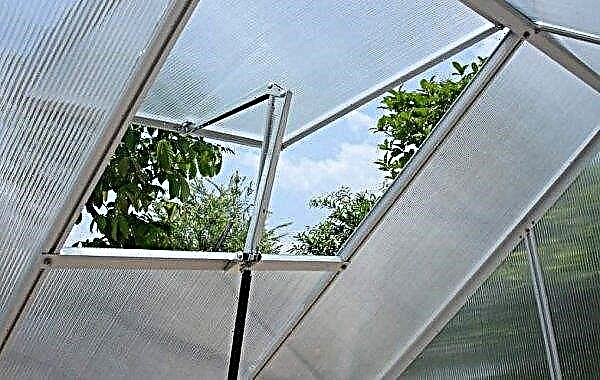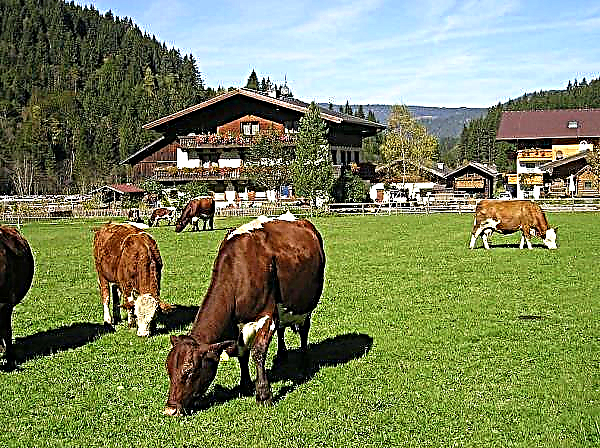Panicled hydrangea is a popular garden plant that blooms for more than six months (May-October). In order for the bush to please with its color and be healthy, it is important to properly care for it. Particular attention should be paid to preparing for wintering and care after it wakes up in the spring.
Panicled Hydrangea Care in Autumn
Autumn care is very important because it helps to survive hydrangeas in winter and not lose decorative qualities. Prepare the plant for wintering should begin in September. Preparation includes top dressing and pruning. Watering in the fall is almost no longer carried out, since the amount of rain is enough to keep the soil moist. Namely, this is what hydrangea needs.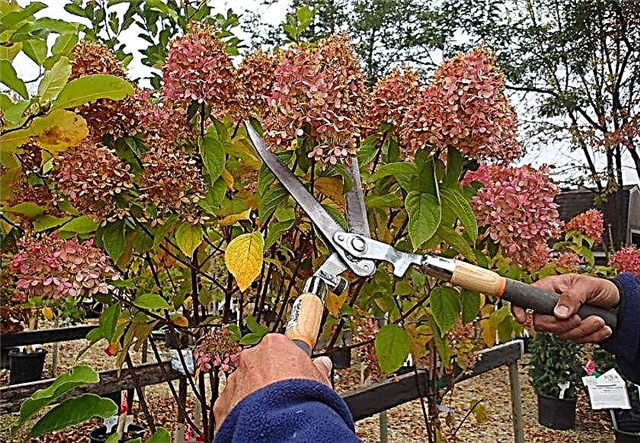
Pruning
With the onset of autumn, pruning of panicled hydrangea is necessary.
Did you know? Hydrangea was first brought to Europe from Japan at the beginning of the XIX century. Then there were only 2 of its species: white and red.
The procedure can be divided into several stages:
- Carefully inspect the bush. Determine which shoots are the thinnest, respectively, they became the growth of this year.
- Pruner cut off all thin shoots, as well as those in which there is no viability.
- Skeletal thicker branches should not be completely cut, leave up to 3 buds. If sanitary pruning is needed, carry out the procedure without sparing the bush.
- Carry out the formation of the crown, removing the entire undergrowth.

Top dressing
The bush is fed in early September. During this period of time, the plant needs potassium-phosphorus fertilizers. Potassium helps to strengthen the roots and provides reliable protection against frost. This chemical element helps lower the temperature at which the water content of the shrub tissue freezes. Phosphorus increases the immunity of the plant, which helps to cope with diseases. Also, this type of top dressing contributes to the nucleation of the kidneys, which is the key to the appearance of numerous inflorescences in the coming season.
Important! It is not necessary to feed with fertilizers that contain nitrogen. They activate the formation of buds and branches that can not withstand winter frosts, and this will harm the entire bush.
Superphosphates and potassium sulfate are more often used for the procedure. 30 g of each product is dissolved in 10 l of warm water. Dosage - 7 liters under the bush. Organic fertilizers are also introduced - rotted manure, compost, peat. They are scattered around the near-stem circle and mulching the soil. This will protect the root system of the plant from low temperatures.
Preparing for winter outdoors
Basically, panicle hydrangea is transplanted into a pot and transferred to a cool place. But sometimes gardeners decide to leave the plant to winter in the open ground. In this case, it must be remembered that in addition to top dressing and trimming, it needs another type of preparation. It is recommended to prepare pegs in advance, the height of which will be 1/3 of the size of the bush. They need to be driven around hydrangeas and tied to them branches using a rope or fabric ties.
Did you know? Hydrangea cultivation began only in 1900, and now there are, according to various sources, from 52 to 70 flower varieties.
Shelter Methods
The shrub tolerates cold well, but if the temperature drops below –35 ° C in your area, you must use one of the following shelter methods:
- Prepare a board 25 cm wide and as long as the height of a shrub. Drive nails over the entire surface. Place it on the ground surface. The branches are tied with fabric ties and put on the board. Lock the shoots using a rope. Cover everything with dry foliage, sawdust and pine branches. Wrap spanbond on top, and then polyethylene. The film can be fixed by laying stones on the edges.
- Shrub must be wrapped in spanbond. Around the frame, using a mesh of metal, observing a distance of 30 cm. The design must exceed the height of the plant by at least 12-15 cm. Inside, pour dry foliage. This method is the most popular.
- Cover the circle near the trunk of the shrub with branches of needles and lay on them shoots of hydrangea. Fasten the branches at the center with wire brackets. From above it is also necessary to lay out a layer of spruce branches and spunbond in turn. Cover everything with sawdust and peat, and then again cover the branches with needles. And at the very end cover with polyethylene to protect against moisture.
Video: shelter of young panicle hydrangea for the winter
How to restore a flower in spring
In the spring of hydrangea, maximum attention is required so that the bush wakes up and begins to develop. First you need to remove the shelter and clean the trunk circle of the mulch, which served as a heater. Inspect the bark and shoots. Right now, the bush needs pruning, which stimulates its growth and development of branches. The procedure can be carried out in March, but it is better to wait until the weather normalizes. Indeed, sometimes even in April, frosts can occur at night.
To correctly trim the shrub, you must:
- Trim damaged branches.
- Remove branches that are frozen.
- Cut thin shoots.
- Shorten the branches, which one year to 4 buds.
In addition, it should:
- feed the plant;
- carry out hydration;
- treat against diseases and pests.
The main direction in this period is the emergence of buds, the formation of new shoots and foliage. In order for the process to proceed intensively, nitrogen will be needed. Potassium sulfate and a urea mixture are better suited. It’s easy to prepare the fertilizer: you need to take 30 g of each product and dissolve in 10 l of water. Dosage - 6 liters per bush. You can also take 1 liter of slurry and dilute it in 10 liters of water. Pour the solution until completely absorbed.
Important! Proper prevention is always better than treatment, since most drugs are toxic and not only beneficial but also harmful to the plant..
Watering hydrangeas should be regular, you need to ensure that the soil is always moist, but not wet. It is also necessary to carry out preventive treatment for diseases and pests by treating the shrub with Bordeaux liquid, copper chloride, copper sulfate or other fungicidal preparations. The main thing in caring for hydrangea is to do everything on time and follow all the recommendations. This also applies to winter preparations. As a result of correctly pruning, regular watering, warming and timely top-dressing, the shrub will be healthy, which means it will please with fast growth and long beautiful flowering.
The main thing in caring for hydrangea is to do everything on time and follow all the recommendations. This also applies to winter preparations. As a result of correctly pruning, regular watering, warming and timely top-dressing, the shrub will be healthy, which means it will please with fast growth and long beautiful flowering.



